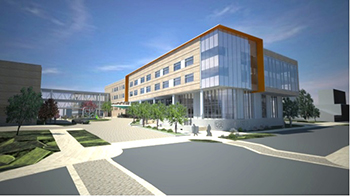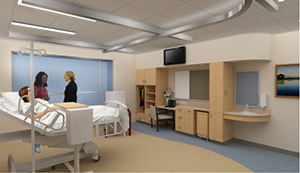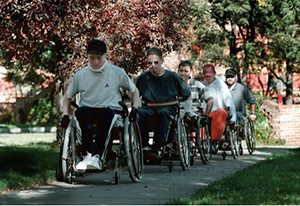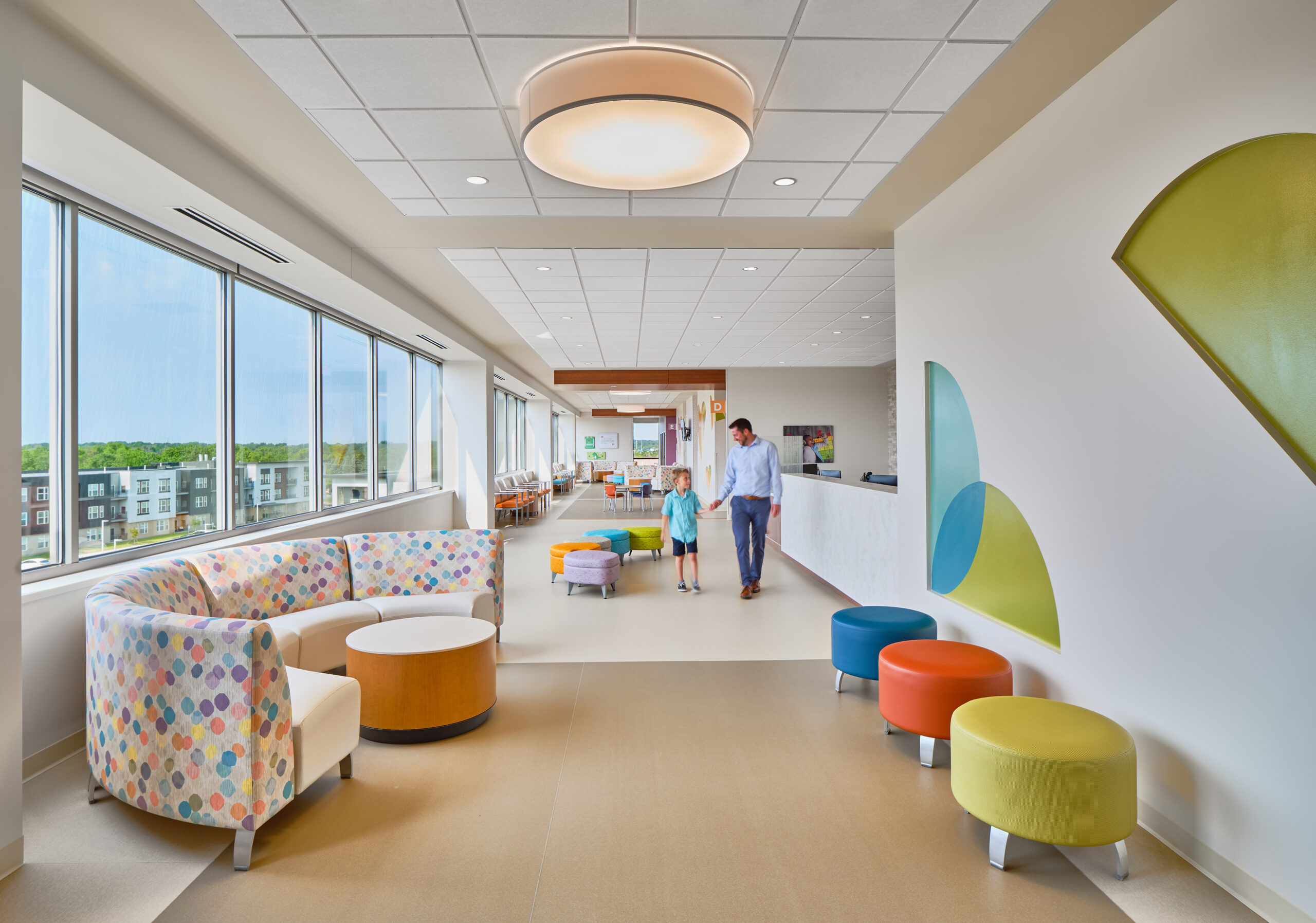 DENVER, Colo. — RTA Architects likes to say that architects with small egos offer their clients big benefits. Such is the case with Craig Hospital’s $90 million expansion and renovation — a 60-month project that will set a new standard for collaboration in an extremely complex health care environment.
DENVER, Colo. — RTA Architects likes to say that architects with small egos offer their clients big benefits. Such is the case with Craig Hospital’s $90 million expansion and renovation — a 60-month project that will set a new standard for collaboration in an extremely complex health care environment.
The project consists of approximately 85,000 square feet of new space, and approximately 135,000 square feet of existing space of renovation. The expansion will double the size of Craig’s outpatient clinic, including a new, state-of-the-art aquatic therapy pool and 52 new private rooms.
Craig has treated more spinal cord injury patients than any other single facility in the world, and has been rated in the Top Ten Rehab Hospitals by US News & World Report for 24 years. It’s remarkable given the antiquated environment staff has worked in since the hospital moved into the West Building in 1970. Sixteen months into the expansion and renovation’s five-year timeline, the site, foundation and updated utilities are complete; Clarkson Street is closed to allow for safe pedestrian and wheelchair access and the long-awaited unification of the campus buildings; and steel is now being erected. Projected completion is late 2016.
RTA Architects, serving as architect of record, partnered with design architect SmithGroupJJR and GE Johnson Construction to resolve an extremely complex problem: How do you build a new facility on top of and inside an operating brain and spinal cord injury rehabilitation hospital without losing beds or disrupting patients?
 The answer, according to Randy Thorne, AIA, RTA’s principal in charge, was to pull in experts from all disciplines and break the enormous project into 22 pieces. “The planning process took a full year,” explained Thorne. “That began with a week of full immersion at Craig by the architectural team.” Working in an integrated project approach with GE Johnson Construction, the team co-located to the Craig Hospital campus during concept and pre-schematic design to build the project plan, design, and budget.
The answer, according to Randy Thorne, AIA, RTA’s principal in charge, was to pull in experts from all disciplines and break the enormous project into 22 pieces. “The planning process took a full year,” explained Thorne. “That began with a week of full immersion at Craig by the architectural team.” Working in an integrated project approach with GE Johnson Construction, the team co-located to the Craig Hospital campus during concept and pre-schematic design to build the project plan, design, and budget.
When first interested in the prospect of the Craig Hospital project, RTA Architects went straight to the nation’s top-designed brain and spinal cord hospitals to learn what few people know about the needs of this small population of patients. Thorne explained, “We discovered that the National Intrepid Center of Excellence in Bethesda, Maryland’s National Military Medical Center, the VA San Antonio Polytrauma and the Center for the Intrepid were each outstanding facilities designed for brain and spinal cord injured patients and all three had been designed by SmithGroupJJR. Because their expertise was staring right back at us, we decided they needed to be on our team. RTA is always reaching out to find specialists who will serve our clients. Our egos don’t stand in the way of what’s best for them.”
 According to Thorne, every building ought to take on the character of its owner and occupants — not of the architect. “Some firms forget this and I think it’s a disservice. We knew right up front that the only way we would be able to fully understand the character and the needs of Craig Hospital would be to watch the interaction between Craig staff and patients.” Thorne and SmithGroupJJR’s Brenna Costello spent an entire week in full immersion at Craig.
According to Thorne, every building ought to take on the character of its owner and occupants — not of the architect. “Some firms forget this and I think it’s a disservice. We knew right up front that the only way we would be able to fully understand the character and the needs of Craig Hospital would be to watch the interaction between Craig staff and patients.” Thorne and SmithGroupJJR’s Brenna Costello spent an entire week in full immersion at Craig.
“You go there and there’s a certain aura, a certain patient-staff relationship, that you can’t capture in a white paper. You have to experience it. There’s a Craig way. The only way we could get that at the beginning of the project, when you need to start the design process, was immersion,” Thorne said.
Seventeen months into the project, the architectural team as well as the contractors understand the Craig way. “But we needed to know their culture one month in as it was imperative to initiate the design concepts,” explains Thorne. “That immersion week was really key. We watched the interactions between staff and patients, the smiles on their faces, the concern with family members’ comfort and that they were getting the right information. We saw them brief a family and a patient in a room with six or seven professionals.”
From a design perspective, brain and spinal cord rehabilitation presents its unique challenges. The RTA/SmithGroupJJR team found that, even though you can design simple “fixes” for patients in wheelchairs, Craig’s rehabilitation staff feels it’s almost pandering to provide amenities that graduates won’t find in the real world.
 Once graduates of the Craig program leave, they’ll have to cope with round door knobs, ill-fitted bathrooms, curbs, thresholds and the like. “All of these aspects of reality are present in our design for the new Craig Hospital facility,” Thorne adds.
Once graduates of the Craig program leave, they’ll have to cope with round door knobs, ill-fitted bathrooms, curbs, thresholds and the like. “All of these aspects of reality are present in our design for the new Craig Hospital facility,” Thorne adds.
Thorne admits the architectural team found the immersion experience humbling. “When we pulled a nurse or therapist aside and asked what they needed in a new work space, we’d get a response like, ‘I’ve got plenty of room…I don’t need a window,’ and that’s a staff member working out of a five foot by seven foot closet. They’re always focused on helping the patient. These wonderful conversations we had were consistent across all departments at Craig. We had to drag these people out of their makeshift office spaces to fully understand what was important for the end users of the new building.
“Full immersion, and bringing on SmithGroupJJR, with their expertise specific to designing for brain and spinal cord injured patients, allowed us to get right into the most important part of the project, which is this complicated task of building a new hospital around the people who operate here daily and not interrupting them. At the same time, we needed to create a design that would improve the operational environment for all who will use the hospital — patients, families, nurses, doctors, therapists and other staff,” Thorne explained.
After decades of working with patients two or three to a room, the new facility will offer 52 new private rooms in order to allow all 93 beds to occupy a private room. This allows for more privacy for family interaction and conversations with physicians and the rehabilitation team, full environmental controls and adaptable stimulus environments for TBI and SCI patients. It also will provide much-needed space for The PEAK Center at Craig Hospital, which houses wellness and fitness member programs and state-of-the-art fitness equipment for inpatients, outpatients and community members with neurological disabilities. To date, approximately 170 community members are members of The PEAK Center at Craig Hospital.
Paul Reu, RTA’s project manager, feels the closing of Clarkson Street was one of the most rewarding aspects of the first phase of the project. “Seeing the celebration the Craig staff had, literally turning Clarkson Street into a picnic area with music and dancing, wheeling patients around in the safety of the newly-barricaded street, added to our understanding of the importance of every design decision we made,” Reu explained. The old Clarkson Street will become the new cul-de-sac main entrance and accessible front garden area, Reu added.
According to Reu, the closure of Clarkson Street required multiple phases to achieve the final plaza design while maintaining access to the building entrance and the neighboring East Building entrance. Construction of the Craig Hospital addition and renovations while the facility remains fully occupied adds another level of complexity, making the team approach all the more vital to the project’s success. Five major phases are planned with an additional seven sub phases to allow for the construction of the superstructure and interior renovations within the occupied hospital.
GE Johnson utilized their dedicated Systems Integration Group, and their health care
preconstruction team to develop a target design and cost model that achieved the desired program while marrying the extraordinarily complex phasing challenges.
“GE Johnson is incredible at scheduling and we needed scheduling wizardry. But even more importantly, they were 100 percent invested from the first day of the project,” Thorne said. “To have a contractor on your team that is wholeheartedly in the project from day one while you’re designing, developing solutions that aid the design process and helping you help the client get the best value for their dollar is a gift. This has not been the industry norm. Often, the architect-contractor relationship doesn’t operate this smoothly.”
GE Johnson even developed a website dedicated for Craig staff, patients and end users to communicate logistics and daily construction activities weeks in advance to engage input from stakeholders into the design and construction process.
“The fact that this enormous undertaking is paid for by fundraising added another dimension for the architectural and construction team. “Every dollar is just holy to these people,” Thorne said. “Each person on our team understands this and focuses on solid design and construction decisions. With RTA, SmithGroupJJR and GE Johnson we’ve got a collective of professionals who are all fully invested in Craig’s goals. Without that kind of collaboration this project would not be unique to Craig and not reflective of the Craig way.”
When asked what is most compelling about the project, Craig’s President and CEO Mike Fordyce answered, “The deep collaboration going on here is remarkable. RTA Architects, SmithGroupJJR, and GE Johnson Construction are responsive to our patient needs to the point of appointing one of GE Johnson’s superintendents to be the staff/patient liaison. She is on call 24/7 for three years, to ensure no activity will impact patient comfort. Shutting down drilling for three hours to accommodate one patient’s need to nap and be relocated to a quieter room is one example of their level of commitment to the Craig philosophy of patient-centered care. For us, it’s the dream team we needed to carry out such an important community project.”
The hospital is funding $40 million of the project through cash reserves and the sale of bonds. The Craig Hospital Foundation is raising $50 million through its “Redefining Return On Investment (ROI)” capital campaign. The hospital has a remaining $17.5 million to fundraise.
Stuart Coppedge, AIA, LEED AP, is a principal with RTA Architects, a Colorado Springs, Colo., architecture, interiors, and planning firm serving primarily health care, K-12, and retail clients. Stuart enjoys a multifaceted practice, engaging with multiple client types and leading the firm’s business development efforts. He also is a member of the national board of directors of the American Institute of Architects.





